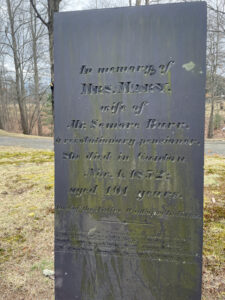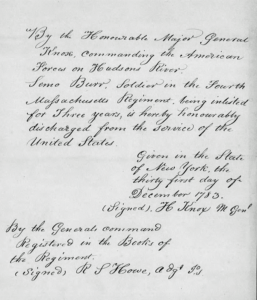True Tales: The life and times of Semo Burr
By George T. ComeauAlong a path inside the gate of the Canton Corner Cemetery, quite near the First Parish Church, there is a tall slate headstone. The stone was set in 1852 and the inscription reads, “In memory of Mrs. Mary, wife of Seymour Burr, a Revolutionary pensioner. She died in Canton, November 1, 1852, aged 101 years, last of the Punkapog Indians.”
The one thing wrong with this statement is that Mary’s family all attended her funeral. The epitaph is punctuated with a poem, which in part reads, “Like the leaves in November, so sure to decay, have the Indian tribes all passed away.” It is simply not true that the tribal connection ended with Mary’s death.
Whether Mary was actually 101 years old is very hard to verify. We do know that a “tradition among her neighbors asserts that she was born on the night of the Great Lisbon Earthquake,” which occurred in 1755. That would place her at 97 years of age when she died. Another conflict on her age is deduced from an oath that her husband made in 1820 that swore she was then 62 years of age. As we all know, it is impolite to ask a woman her age, and so we may never know the answer.
That said, we know that Mary lived just off present-day Pleasant Street quite near the apple orchard once owned by Simon George. In 1781, Mary had married Jacob Wilbor and they had a son who was buried in an unmarked native American burying ground. The remains of that boy, in all likelihood, are stored on a shelve at the Peabody Museum at Harvard University. Or, those remains may still be at the unmarked cemetery after an archeological discovery in 1998 found human remains within the boundaries of a new subdivision.
More fascinating, though, is the story of Mary’s second husband: Seymour Burr. There is a small dirt path on Pleasant Street called Burr Lane, and it is named for this fascinating man. Again, actual fact still escapes this story, owing to the fact that Burr was Black and was a former slave. As with many slaves in Colonial America, it is very difficult to trace his route and arrival as his name was changed to reflect his slave owner’s name. There is plenty of “legend” here and very little fact as such. The story goes that in the case of Seymour Burr, he took the first name and surname of his owner. He was either born in 1754 or 1762. Burr was owned by one Seymour Burr, brother of Colonel Aaron Burr (the third vice president of the United States) and lived in Connecticut when it was part of the North American British colonies. There is but one problem with this story: Aaron Burr did not have a brother named Seymour. Historians have been repeating folklore that is not rooted in fact.
It was said that Burr was born in Africa and his enlistment information supports that he was born in Guinea. Most definitely Black, he stood at 5 feet, 6 inches tall and had the occupation of laborer. Folklore held that he was the son of a prince and had royal blood, and fact shows that he was exceedingly brave. In the earliest conflicts of the American Revolution the British Army promised the personal freedom of African American slaves who enlisted or escaped to fight against the Continental Army. As noted by William Nell, a Black abolitionist writing in the mid-19th century, “[Burr] seized an occasion to induce several of his fellow slaves to escape in a boat, intending to join the British, that they might become freemen; but being pursued by their owners, armed with the implements of death, they were compelled to surrender.”
According to Nell, “Burr’s master, contrary to his expectation, did not inflict corporeal punishment, but reminded him of the kindness with which he had been treated, and asked what inducement he could have for leaving him. Burr replied that he wanted his liberty. His owner finally proposed, that if he would give him the bounty money, he might join the American army, and at the end of the war be his own man. Burr, willing to make any sacrifice for his liberty, consented, and served faithfully during the campaign, attached to the Seventh Regiment, commanded by Colonel, afterwards Governor Brooks, of Medford. He was present at the siege of Fort Catskill, and endured much suffering from starvation and cold. After some skirmishing, the army was relieved by the arrival of Gen. Washington, who, as witnessed by him, shed tears of joy on finding them unexpectedly safe.”
If this is indeed true, that places Burr in a few very key places during the American Revolution. Chief among historian’s records is a claim that he had a presence at the Battle of Bunker Hill alongside other Black fighters, including Peter Salem. And some sources credit Burr with being among the men surviving the winter at Valley Forge. Neither of the claims have been verified. The Massachusetts State Archives has the service record for Burr and shows that he served for at least three years, between 1781 and 1783.
Much of Burr’s service took place in the Hudson Valley as the pivot point between the north and the south. It was a stalemate of sorts; the conflict had moved out of New England and the various forts held by George Washington’s army in the Hudson Valley were guarded against supply raids. As the British were pinned down in New York City, the strategically placed forts known as the York Huts, two miles from present-day West Point, were critical to the holding pattern. In New York on December 31, 1783, none other than Major General Henry Knox signed Burr’s discharge papers.
After his service, Burr was given his promised freedom. After the war he found his way to Sharon and finally to Canton. In March 1792, a marriage intention was published. Burr married the widow Mary Wilbor, who was one of the Ponkapoag tribe. In marrying her, Burr lived on the land in Stoughton that is now Canton. The property was once Simon George’s, including a small family burying ground that is now a protected historic site. In 1805, Burr received a deed from the guardians of the Ponkapoag Indians for the six acres he was then living upon.
During the Revolution and to friends and family here in Canton, he was known as Semo and was well liked. One neighbor, Friend Crane, submitted a letter in support of Semo’s pension and wrote that he found Semo and his wife to be honest and “of good moral character.” Another friend observed that he was “most respected by all.” Taking up farming, he owned a cow, a pig, one sheep, and two parcels of land comprising more than 16 acres. Mary and Semo had children and he was able to provide for his family with an annual pension for his military service. The pension records total more than 50 pages and from that we know he was paid $127.22 in May 1818 as arrears for his service, and thereafter received $50 a year until he died.
The marriage to Mary was fraught with threats and abuse. A local historian wrote that “there were times when the heart even of this brave soldier faltered, and when for the moment he wished himself elsewhere.” Quotes containing expletives pepper the historian’s notes when characterizing the marriage.
Semo Burr died on February 17, 1837, and was either buried in that small plot behind the house, or in an unmarked grave for people of color at Canton Corner. After he died, Mary fought for over six years in order to secure the widow’s pension. There was a question as to whether they were actually ever legally married, and several prominent residents and friends all filed affidavits supporting Mary’s claim. She was awarded $80 per year as her share of Burr’s pension until she passed away in 1852.
The town of Canton and indeed America owe a great debt to men like Seymour Burr. There is no marker for this man, and little to note his life here in Canton. In time, more needs to be done to recognize his place and commemorate the bravery and strength of our revolutionary hero named Seymour Burr.
Special thanks to Jonathan Lane at Rev250 for his research assistance.
Short URL: https://www.thecantoncitizen.com/?p=85283












